How Does OpenSea Make Money? The OpenSea Business Model In A Nutshell
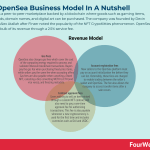
OpenSea is a peer-to-peer marketplace backed by a blockchain where goods such as gaming items, trading cards, domain names, and digital art can be purchased. The company was founded by Devin Finzer and Alex Atallah after Finzer noted the popularity of the NFT CrypoKitties phenomenon. OpenSea makes the bulk of its revenue through a 2.5% service fee. The fee is collected whenever a NFT is sold on the platform. OpenSea charges gas fees to buyers and sellers to cover the cost of applicable blockchain transactions. There are also account registration and contract approval fees when a new account is opened and a new cryptocurrency is used, respectively.
History of OpenSeaOpenSea is a peer-to-peer marketplace backed by a blockchain where goods such as gaming items, trading cards, domain names, and digital art can be purchased.
The company was founded in 2017 by Devin Finzer and Alex Atallah at a time when non-fungible token (NFT) projects were just starting to attract interest. Finzer became interested in NFTs after witnessing the CryptoKitties project, a tech culture phenomenon where people were paying hundreds of thousands of dollars for collectible video game cats. More broadly speaking, Finzer also wondered if there was more to crypto than simply finance and currencies.
A few months later, he teamed up with software developer Atallah, a Stanford graduate who also had a burgeoning interest in cryptocurrency. They presented a rough idea to a Techcrunch Hackathon in September and were then accepted into the Y Combinator program to take the project further. After an initial pivot, Finzer and Atallah returned to CrypoKitties and its underlying infrastructure. Using something similar, they decided to build a digital marketplace where users could buy or sell NFTs in multiple categories. The OpenSea platform launched in February 2018, describing itself as “eBay for cryptogoods.”
Initially, the OpenSea marketplace relied on game developers to drive business – though new categories were continuously added. The company managed to secure a $2 million round of funding early and in December, acquired competitor marketplace Atomic Bazaar. By the end of 2019, OpenSea was considered to be the leading NFT marketplace.
This position was solidified after the COVID-19 pandemic forced people to stay at home, with the NFT market itself experiencing rapid growth. In fact, NFT sales for 2020 were $94.8 million, equivalent to 30,000% year-on-year growth. During this time, the company had just seven employees and struggled to scale its operations to meet demand.
OpenSea is on track to surpass $27.5 billion in sales volume for 2021 with average daily fee revenue amounting to $4.2 million.
OpenSea revenue generationOpenSea has a rather simple revenue generation strategy.
The company makes most of its money by charging service fees whenever a digital asset is sold on its platform.
The service fee is 2.5%, which means an NFT selling for $200 earns OpenSea $5.
Gas feesOpenSea also charges gas fees which cover the cost of the computing energy required to process and validate Ethereum blockchain transactions.
Buyers pay the gas fee when purchasing fixed-price items, while sellers pay the same fee when accepting offers.
Gas fees are also payable when canceling a listed NFT, canceling a bid, converting WETH to ETH (and vice versa), and freezing metadata.
Account registration feesNew sellers to the OpenSea platform must pay an account initialization fee before they can list.
Ostensibly, these fees are charged to enable trading between the seller’s wallet and OpenSea. The fee also allows the company to access transfer items after a sale occurs.
Contract approval feesUsers wishing to sell an item minted through a custom NFT contract will also need to pay a one-time approval fee for authorizing transactions.
This fee is also payable whenever a new cryptocurrency is used for the first time and includes currencies such as DAI and USDC.
Connected Business Concepts According to Joel Monegro, a former analyst at USV (a venture capital firm) the blockchain implies value creation in its protocols. Where the web has allowed the value to be captured at the applications layer (take Facebook, Twitter, Google, and many others). In a Blockchain Economy, this value might be captured by the protocols at the base of the blockchain (for instance Bitcoin and Ethereum). However, according to blockchain investor Paivinen due to ease of forking, incentives to compete and improved interoperability and interchangeability also in a blockchain-based economy, protocols might get thinner. Although the marginal value of scale might be lower compared to a web-based economy, where massive scale created an economic advantage. The success of the Blockchain will depend on its commercial viability!
According to Joel Monegro, a former analyst at USV (a venture capital firm) the blockchain implies value creation in its protocols. Where the web has allowed the value to be captured at the applications layer (take Facebook, Twitter, Google, and many others). In a Blockchain Economy, this value might be captured by the protocols at the base of the blockchain (for instance Bitcoin and Ethereum). However, according to blockchain investor Paivinen due to ease of forking, incentives to compete and improved interoperability and interchangeability also in a blockchain-based economy, protocols might get thinner. Although the marginal value of scale might be lower compared to a web-based economy, where massive scale created an economic advantage. The success of the Blockchain will depend on its commercial viability!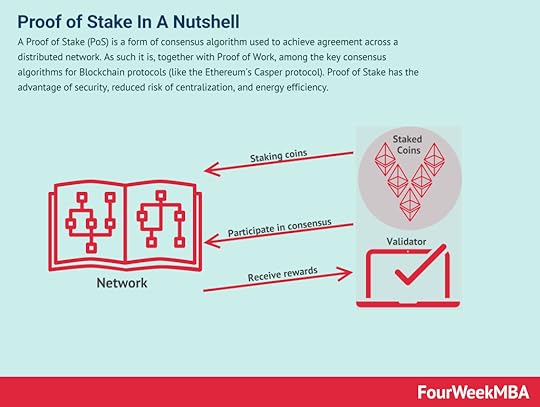 A Proof of Stake (PoS) is a form of consensus algorithm used to achieve agreement across a distributed network. As such it is, together with Proof of Work, among the key consensus algorithms for Blockchain protocols (like the Ethereum’s Casper protocol). Proof of Stake has the advantage of security, reduced risk of centralization, and energy efficiency.
A Proof of Stake (PoS) is a form of consensus algorithm used to achieve agreement across a distributed network. As such it is, together with Proof of Work, among the key consensus algorithms for Blockchain protocols (like the Ethereum’s Casper protocol). Proof of Stake has the advantage of security, reduced risk of centralization, and energy efficiency.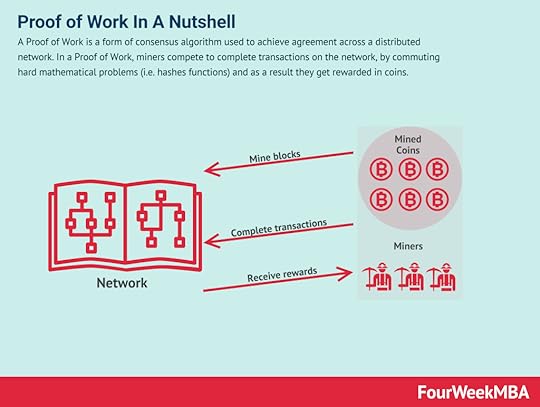 A Proof of Work is a form of consensus algorithm used to achieve agreement across a distributed network. In a Proof of Work, miners compete to complete transactions on the network, by commuting hard mathematical problems (i.e. hashes functions) and as a result they get rewarded in coins.
A Proof of Work is a form of consensus algorithm used to achieve agreement across a distributed network. In a Proof of Work, miners compete to complete transactions on the network, by commuting hard mathematical problems (i.e. hashes functions) and as a result they get rewarded in coins.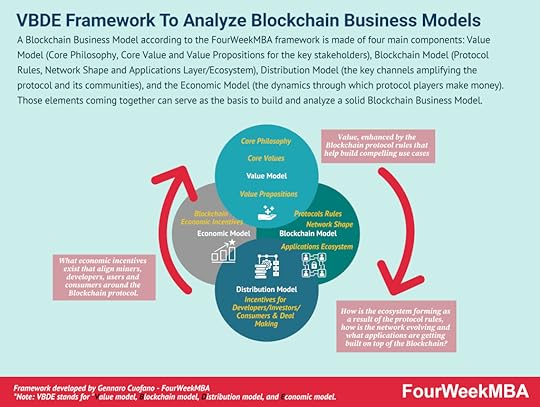 A Blockchain Business Model according to the FourWeekMBA framework is made of four main components: Value Model (Core Philosophy, Core Values and Value Propositions for the key stakeholders), Blockchain Model (Protocol Rules, Network Shape and Applications Layer/Ecosystem), Distribution Model (the key channels amplifying the protocol and its communities), and the Economic Model (the dynamics/incentives through which protocol players make money). Those elements coming together can serve as the basis to build and analyze a solid Blockchain Business Model.
A Blockchain Business Model according to the FourWeekMBA framework is made of four main components: Value Model (Core Philosophy, Core Values and Value Propositions for the key stakeholders), Blockchain Model (Protocol Rules, Network Shape and Applications Layer/Ecosystem), Distribution Model (the key channels amplifying the protocol and its communities), and the Economic Model (the dynamics/incentives through which protocol players make money). Those elements coming together can serve as the basis to build and analyze a solid Blockchain Business Model.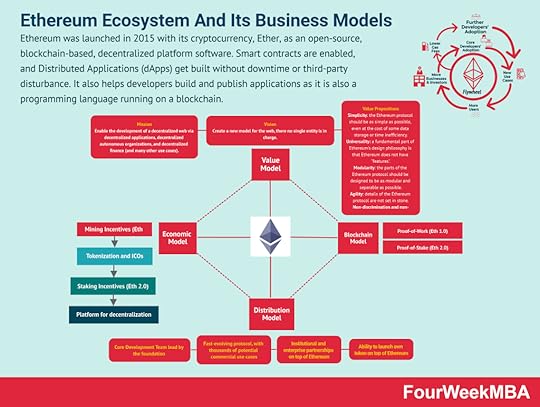 Ethereum was launched in 2015 with its cryptocurrency, Ether, as an open-source, blockchain-based, decentralized platform software. Smart contracts are enabled, and Distributed Applications (dApps) get built without downtime or third-party disturbance. It also helps developers build and publish applications as it is also a programming language running on a blockchain.
Ethereum was launched in 2015 with its cryptocurrency, Ether, as an open-source, blockchain-based, decentralized platform software. Smart contracts are enabled, and Distributed Applications (dApps) get built without downtime or third-party disturbance. It also helps developers build and publish applications as it is also a programming language running on a blockchain. The Graph is an ERC20 Utility Token (built on top of Ethereum) to enable consumers to freely query the blockchain through a fully decentralized database kept by indexers, incentivized by the payment of tokens (called GRT). The network is also ministered by curators and delegators that help maintain a high-quality index.
The Graph is an ERC20 Utility Token (built on top of Ethereum) to enable consumers to freely query the blockchain through a fully decentralized database kept by indexers, incentivized by the payment of tokens (called GRT). The network is also ministered by curators and delegators that help maintain a high-quality index. BAT or Basic Attention Token is a utility token aiming to provide privacy-based web tools for advertisers and users to monetize attention on the web in a decentralized way via Blockchain-based technologies. Therefore, the BAT ecosystem moves around a browser (Brave), a privacy-based search engine (Brave Search), and a utility token (BAT). Users can opt-in to advertising, thus making money based on their attention to ads as they browse the web.
BAT or Basic Attention Token is a utility token aiming to provide privacy-based web tools for advertisers and users to monetize attention on the web in a decentralized way via Blockchain-based technologies. Therefore, the BAT ecosystem moves around a browser (Brave), a privacy-based search engine (Brave Search), and a utility token (BAT). Users can opt-in to advertising, thus making money based on their attention to ads as they browse the web. In 2012, co-founders Christian Larsen and Jed McCaleb created Ripple, a technology acting as both a pre-mined cryptocurrency called XRP and a digital payment platform enabling monetary transactions. Where Ripple is the tech company, XRP is the decentralized ledger.
In 2012, co-founders Christian Larsen and Jed McCaleb created Ripple, a technology acting as both a pre-mined cryptocurrency called XRP and a digital payment platform enabling monetary transactions. Where Ripple is the tech company, XRP is the decentralized ledger. In 2014, Jed McCaleb – which also played a key role in the development of Ripple – created a cryptocurrency to provide fast, reliable, and affordable money transactions. The same cryptocurrency has considerably grown seven years later. It is now one of the most stellar cryptocurrencies to provide a real-time platform that links banks, payment systems, and people. Meet, Stellar!
In 2014, Jed McCaleb – which also played a key role in the development of Ripple – created a cryptocurrency to provide fast, reliable, and affordable money transactions. The same cryptocurrency has considerably grown seven years later. It is now one of the most stellar cryptocurrencies to provide a real-time platform that links banks, payment systems, and people. Meet, Stellar! In early 2019, a joint project between TRON and BitTorrent Foundation called BitTorrent Token came to fruition. BitTorrent Token launched to tokenize in-demand file-sharing protocol and enhance content delivery and bandwidth accessibility with blockchain technology.
In early 2019, a joint project between TRON and BitTorrent Foundation called BitTorrent Token came to fruition. BitTorrent Token launched to tokenize in-demand file-sharing protocol and enhance content delivery and bandwidth accessibility with blockchain technology. Chainlink is considered the most established decentralized oracle network. As an ecosystem housing several decentralized oracle networks running simultaneously. As a decentralized oracle service built on Ethereum, Chainlink has the power to support the development of blockchain solutions for both traditional businesses and enterprises.
Chainlink is considered the most established decentralized oracle network. As an ecosystem housing several decentralized oracle networks running simultaneously. As a decentralized oracle service built on Ethereum, Chainlink has the power to support the development of blockchain solutions for both traditional businesses and enterprises. Uniswap is a renowned decentralized crypto exchange created in 2018 and based on the Ethereum blockchain, to provide liquidity to the system. As a cryptocurrency exchange technology that operates on a decentralized basis. The Uniswap protocol inherited its namesake from the business that created it — Uniswap. Through smart contracts, the Uniswap protocol automates transactions between cryptocurrency tokens on the Ethereum blockchain.
Uniswap is a renowned decentralized crypto exchange created in 2018 and based on the Ethereum blockchain, to provide liquidity to the system. As a cryptocurrency exchange technology that operates on a decentralized basis. The Uniswap protocol inherited its namesake from the business that created it — Uniswap. Through smart contracts, the Uniswap protocol automates transactions between cryptocurrency tokens on the Ethereum blockchain. In essence, Polkadot is a cryptocurrency project created as an effort to transform and power a decentralized internet, Web 3.0, in the future. Polkadot is a decentralized platform, which makes it interoperable with other blockchains.
In essence, Polkadot is a cryptocurrency project created as an effort to transform and power a decentralized internet, Web 3.0, in the future. Polkadot is a decentralized platform, which makes it interoperable with other blockchains. Designed and created as an alternative to Ethereum, Cardano claims to be the first decentralized blockchain protocol to use a scientific approach and undergo a peer evaluation.
Designed and created as an alternative to Ethereum, Cardano claims to be the first decentralized blockchain protocol to use a scientific approach and undergo a peer evaluation. Solana is a blockchain network with a focus on high performance and rapid transactions. To boost speed, it employs a one-of-a-kind approach to transaction sequencing. Users can use SOL, the network’s native cryptocurrency, to cover transaction costs and engage with smart contracts.
Solana is a blockchain network with a focus on high performance and rapid transactions. To boost speed, it employs a one-of-a-kind approach to transaction sequencing. Users can use SOL, the network’s native cryptocurrency, to cover transaction costs and engage with smart contracts.Get The 450 Pages Blockchain Business Models Book

Read Also: Proof-of-stake, Proof-of-work, Bitcoin, Dogecoin, Ethereum, Solana, Blockchain, BAT, Monero, Ripple, Litecoin, Stellar, Dogecoin, Bitcoin Cash, Filecoin.
Main Free Guides:
Business ModelsBusiness StrategyBusiness DevelopmentDigital Business ModelsDistribution ChannelsMarketing StrategyPlatform Business ModelsRevenue ModelsTech Business ModelsBlockchain Business Models FrameworkThe post How Does OpenSea Make Money? The OpenSea Business Model In A Nutshell appeared first on FourWeekMBA.



